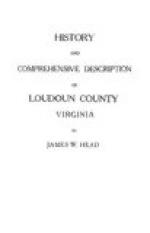Garnett’s Brigade, to which the 8th Virginia regiment was attached, was led into action during the memorable charge on the third day of the battle of Gettysburg. The brigade moved forward in the front line, and gained the enemy’s strongest position, where the fighting became hand to hand and of the most desperate character. It went into action with 1,287 men and 140 officers, and after the struggle, of this number, only about 300 came back slowly and sadly from the scene of carnage. General Garnett, himself, was shot from his horse while near the center of the advancing brigade, within about twenty-five paces of the “stone fence,” from behind which the Federals poured forth their murderous fire.
The Loudoun Rangers (Federal).
This volunteer organization consisted of two companies of disaffected Virginians, all of whom were recruited in the German settlements northwest of Leesburg. Company A, at the outset, was commanded by Captain Daniel M. Keyes, of Lovettsville, who later resigned on account of wounds received in action. He was succeeded by Captain Samuel C. Means, of Waterford. Company B’s commander was Captain James W. Grubb. The total enlistment of each company was 120 and 67, respectively. All the officers and privates were of either German, Quaker, or Scotch-Irish lineage, the first-named class predominating.
The command was mustered into the Federal service at Lovettsville, the 20th day of June, 1862. Its historian, Briscoe Goodhart, a member of Company A, in his History of the Loudoun (Virginia) Rangers, has said that it “was an independent command, organized in obedience to a special order of the Honorable Edwin M. Stanton, Secretary of War, and was at first subject to his orders only, but subsequently merged into the Eighth Corps, commanded at that time by the venerable Major General John Ellis Wool....”
The “Rangers,” as the name implies, were scouts and, in this highly useful capacity, served the enemies of their State with shameless ardor. But, as a body, they fought few engagements and none of a decisive nature. Their first and, perhaps, sharpest encounter happened in and around the old Baptist Church at Waterford.
The following absolution or justification is offered in the preface to the above-quoted work:
“As the name of their organization indicates, they came from a State which was arrayed in arms against the authority of the National Government. No Governor, or Senator, or Member of Congress guarded their interests; nor was any State or local bounty held forth to them as an allurement. Their enlistment in the Union Army—their country’s army—was the spontaneous outgrowth of a spirit of lofty patriotism.
“As they saw their duty they were not lacking in moral courage to perform that duty; and with no lapse of years shall we ever fail to insist that the principles for which the Rangers contended were eternally right, and that their opponents were eternally wrong.”
Far from being a well-ordered command with a clearly defined modus operandi, the two companies were poorly drilled, imperfectly accoutred, only aimlessly and periodically active, and, moreover, were on the point of dissolution at the outset.




